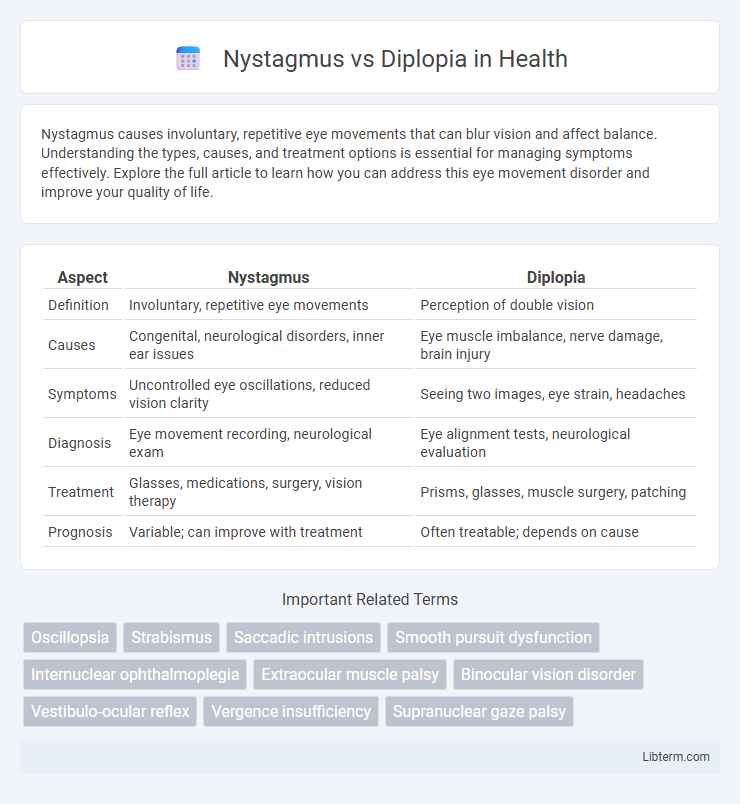Nystagmus causes involuntary, repetitive eye movements that can blur vision and affect balance. Understanding the types, causes, and treatment options is essential for managing symptoms effectively. Explore the full article to learn how you can address this eye movement disorder and improve your quality of life.
Table of Comparison
| Aspect | Nystagmus | Diplopia |
|---|---|---|
| Definition | Involuntary, repetitive eye movements | Perception of double vision |
| Causes | Congenital, neurological disorders, inner ear issues | Eye muscle imbalance, nerve damage, brain injury |
| Symptoms | Uncontrolled eye oscillations, reduced vision clarity | Seeing two images, eye strain, headaches |
| Diagnosis | Eye movement recording, neurological exam | Eye alignment tests, neurological evaluation |
| Treatment | Glasses, medications, surgery, vision therapy | Prisms, glasses, muscle surgery, patching |
| Prognosis | Variable; can improve with treatment | Often treatable; depends on cause |
Understanding Nystagmus: Definition and Causes
Nystagmus is characterized by involuntary, repetitive eye movements that can impair vision and balance, often caused by inner ear disorders, neurological conditions, or congenital factors. Diplopia, in contrast, refers to double vision resulting from misalignment of the eyes, muscular weakness, or nerve damage. Understanding the underlying causes of nystagmus, such as vestibular dysfunction or brainstem pathology, is crucial for accurate diagnosis and targeted treatment.
Diplopia Explained: What Is Double Vision?
Diplopia, commonly known as double vision, occurs when a person sees two images of a single object, often caused by issues with the eye muscles, nerves, or brain. It differs from nystagmus, which is characterized by involuntary eye movements leading to vision instability rather than duplicate images. Understanding diplopia involves recognizing its symptoms, potential neurological or muscular causes, and the importance of prompt medical evaluation for appropriate treatment.
Key Symptoms: Nystagmus vs Diplopia
Nystagmus is characterized by involuntary, rhythmic eye movements, often causing difficulties in maintaining steady vision and spatial orientation. Diplopia, commonly known as double vision, involves seeing two images of a single object, which can result from misalignment of the eyes or neurological issues. Key symptoms distinguishing nystagmus include oscillatory eye motion, while diplopia primarily presents as overlapping or separated visual images.
Eye Movement Disturbances: How They Differ
Nystagmus is characterized by involuntary, rhythmic oscillations of the eyes, often resulting in reduced visual acuity and difficulties with fixation, while diplopia involves the perception of double vision due to misalignment or dysfunction of ocular muscles or neural pathways. Eye movement disturbances in nystagmus manifest as repetitive, uncontrolled eye movements disrupting steady gaze, whereas diplopia arises from impaired binocular coordination causing simultaneous images. Differentiating these conditions relies on assessing the pattern and nature of eye movement abnormalities and their impact on vision clarity.
Underlying Medical Conditions Linked to Nystagmus
Nystagmus is often linked to neurological disorders such as multiple sclerosis, brain tumors, and vestibular system dysfunction, which disrupt normal eye movement control. It can also result from congenital conditions or optic nerve diseases like albinism and Leber's hereditary optic neuropathy. Unlike diplopia, which primarily stems from muscular or nerve palsies affecting eye alignment, nystagmus reflects involuntary rhythmic eye oscillations associated with central nervous system abnormalities.
Common Triggers and Risk Factors for Diplopia
Diplopia, or double vision, is commonly triggered by conditions such as strabismus, cataracts, corneal irregularities, and neurological disorders affecting eye muscle control. Risk factors for diplopia include diabetes, multiple sclerosis, stroke, brain tumors, and traumatic brain injury, which impair nerve signals crucial for coordinated eye movement. In contrast, nystagmus primarily involves involuntary eye oscillations caused by congenital factors, inner ear disorders, or neurological diseases, rather than muscle misalignment or lens defects associated with diplopia.
Diagnostic Methods for Nystagmus and Diplopia
Nystagmus diagnosis primarily involves electronystagmography (ENG) or videonystagmography (VNG) to measure involuntary eye movements and assess vestibular function, alongside detailed clinical eye exams and neurological evaluations. Diplopia evaluation requires comprehensive ocular motility testing, cover-uncover tests to identify misalignment, and neuroimaging like MRI to detect underlying causes such as cranial nerve palsies or lesions. Both conditions benefit from slit-lamp examination and patient history to differentiate central versus peripheral origins effectively.
Treatment Approaches: Managing Each Condition
Treatment approaches for nystagmus primarily involve addressing underlying neurological or ocular causes, with options such as vision therapy, medications like gabapentin or memantine, and surgical procedures like tenotomy to reduce eye movement. Diplopia treatment focuses on correcting the cause of double vision through prism glasses, eye muscle surgery, or botulinum toxin injections to realign the eyes, alongside patching or occlusion therapy in some cases. Both conditions may benefit from multidisciplinary care involving neurologists, ophthalmologists, and rehabilitation specialists to optimize visual function and quality of life.
Impact on Daily Life: Comparing Patient Experiences
Nystagmus causes involuntary eye movements that can lead to blurred vision and difficulty focusing, significantly impacting activities like reading, driving, and navigating through crowded spaces. Diplopia, or double vision, creates overlapping or doubled images that confuse spatial perception, making tasks such as walking stairs, using computers, or recognizing faces challenging. Both conditions disrupt daily life, but nystagmus often results in persistent visual instability, while diplopia's intermittent nature varies with eye alignment and underlying causes.
When to Seek Medical Attention for Vision Problems
Seek medical attention for nystagmus if you experience sudden onset of rapid, involuntary eye movements, changes in vision, or associated symptoms like dizziness or balance issues. For diplopia, immediate care is necessary when double vision occurs suddenly, worsens, is accompanied by eye pain, headache, or neurological symptoms such as weakness or numbness. Early evaluation by an eye specialist or neurologist is crucial to diagnose underlying causes and prevent potential vision loss or complications.
Nystagmus Infographic

 libterm.com
libterm.com